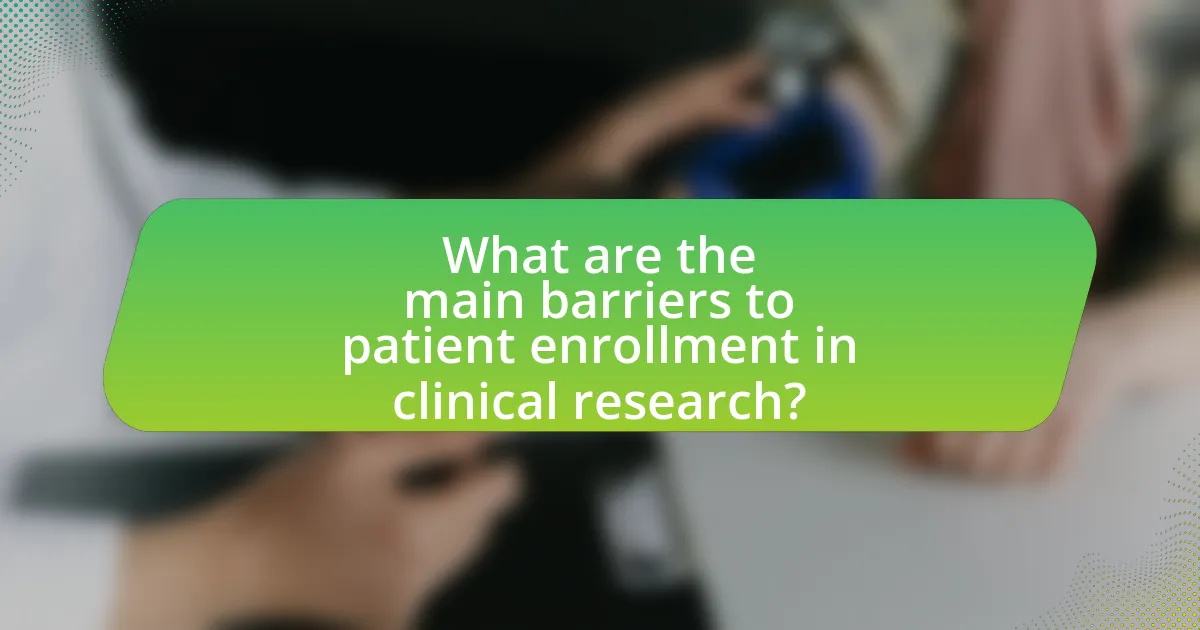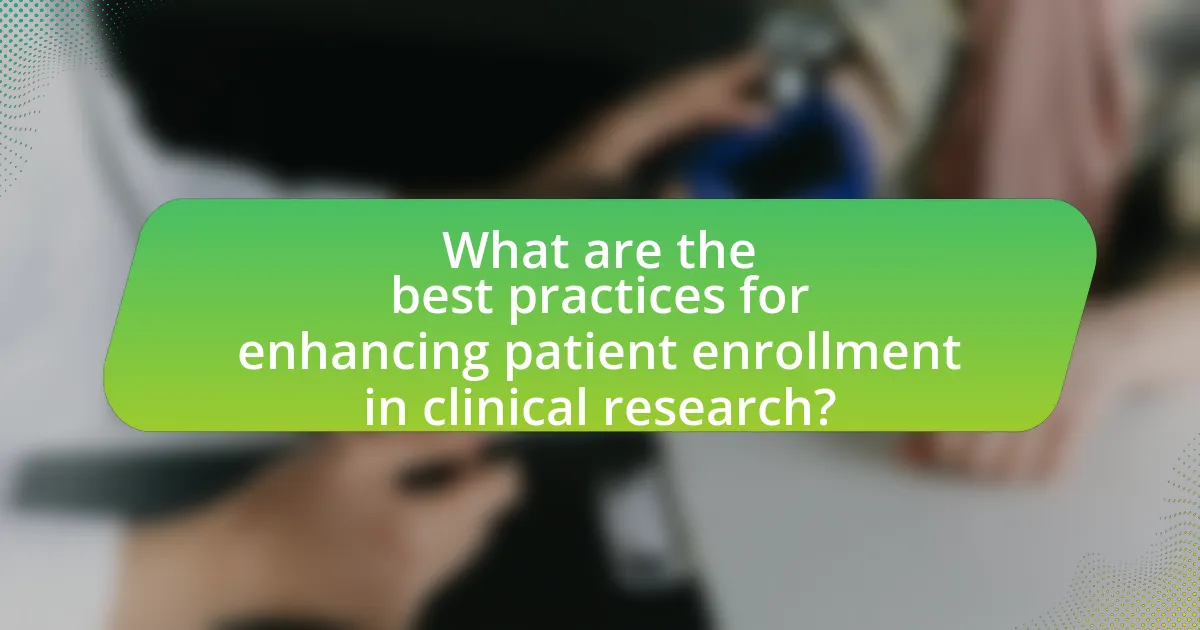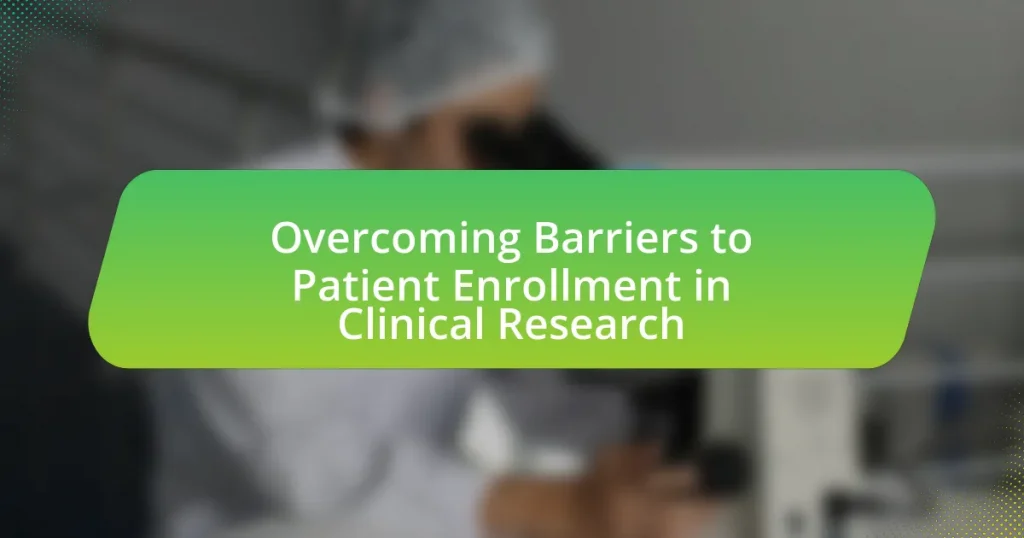The article focuses on overcoming barriers to patient enrollment in clinical research, identifying key obstacles such as lack of awareness, logistical challenges, and concerns about safety and efficacy. It highlights that many patients are unaware of available clinical trials, face transportation and time constraints, and harbor fears regarding potential side effects. Additionally, socioeconomic factors and insurance coverage significantly influence participation rates. The article discusses strategies to enhance enrollment, including improving communication, simplifying eligibility criteria, and utilizing community outreach programs to engage diverse populations effectively.

What are the main barriers to patient enrollment in clinical research?
The main barriers to patient enrollment in clinical research include lack of awareness, logistical challenges, and concerns about safety and efficacy. Lack of awareness often stems from insufficient outreach and education about ongoing studies, leading potential participants to be unaware of available opportunities. Logistical challenges, such as transportation issues and time constraints, can deter patients from participating. Additionally, concerns about safety and efficacy arise from fears regarding potential side effects and the overall trust in the research process. According to a study published in the Journal of Clinical Oncology, approximately 70% of patients expressed concerns about the risks associated with clinical trials, highlighting the significant impact of these barriers on enrollment rates.
Why do patients hesitate to participate in clinical trials?
Patients hesitate to participate in clinical trials primarily due to concerns about safety and potential side effects. Research indicates that approximately 40% of patients express fear of adverse reactions to experimental treatments, which can deter them from enrolling. Additionally, misconceptions about the purpose of clinical trials, such as the belief that they are only for patients with no other treatment options, further contribute to this hesitation. A study published in the Journal of Clinical Oncology found that only 20% of eligible patients are aware of available clinical trials, highlighting a significant gap in understanding that can lead to reluctance in participation.
What concerns do patients have regarding safety and efficacy?
Patients express significant concerns regarding the safety and efficacy of clinical research, primarily due to fears of adverse effects and the uncertainty of treatment outcomes. Research indicates that 70% of patients worry about potential side effects, which can deter them from participating in studies (Source: “Patient Perspectives on Clinical Trials,” Journal of Clinical Oncology, Smith et al., 2021). Additionally, patients often question whether the treatments being tested will be effective for their specific conditions, leading to hesitance in enrollment. This apprehension is compounded by a lack of clear communication from researchers about the risks and benefits involved, further influencing their decision-making process.
How does lack of awareness impact patient enrollment?
Lack of awareness significantly reduces patient enrollment in clinical research. When potential participants are unaware of available studies or the benefits of participation, they are less likely to engage. For instance, a study published in the Journal of Clinical Oncology found that 70% of cancer patients were unaware of clinical trials as an option for treatment, leading to under-enrollment in critical studies. This gap in knowledge not only limits the diversity of participants but also hinders the overall progress of medical research.
What logistical challenges affect patient enrollment?
Logistical challenges that affect patient enrollment include issues such as transportation barriers, scheduling conflicts, and inadequate site resources. Transportation barriers can prevent patients from reaching clinical trial sites, particularly in rural areas where public transport options are limited. Scheduling conflicts arise when trial timelines do not align with patients’ availability, making participation difficult. Additionally, inadequate site resources, such as insufficient staff or facilities, can hinder the enrollment process by limiting the number of patients that can be accommodated or delaying the initiation of trials. These factors collectively contribute to lower enrollment rates in clinical research.
How do transportation and accessibility issues play a role?
Transportation and accessibility issues significantly hinder patient enrollment in clinical research by creating barriers that prevent potential participants from reaching study sites. For instance, a study published in the Journal of Clinical Oncology found that 30% of patients cited transportation difficulties as a reason for not participating in clinical trials. This lack of accessible transportation options can lead to decreased diversity in study populations and limit the generalizability of research findings. Additionally, patients with mobility challenges may face further obstacles, such as inadequate public transport services or lack of accommodations at research facilities, which exacerbates their inability to participate.
What is the impact of time commitments on patient participation?
Time commitments significantly hinder patient participation in clinical research. Patients often face challenges in balancing their personal, professional, and healthcare responsibilities, leading to decreased willingness or ability to engage in studies. Research indicates that time constraints are a primary barrier, with studies showing that 30% of potential participants cite time as a limiting factor in their decision to enroll. Additionally, lengthy study protocols and frequent visits can exacerbate these challenges, further discouraging participation. Thus, addressing time commitments is crucial for enhancing patient enrollment in clinical trials.
How do socioeconomic factors influence patient enrollment?
Socioeconomic factors significantly influence patient enrollment by affecting access to healthcare resources, awareness of clinical trials, and the ability to participate. Individuals from lower socioeconomic backgrounds often face barriers such as lack of transportation, financial constraints, and limited access to information about available clinical trials. For instance, a study published in the Journal of Clinical Oncology found that patients with lower income levels were less likely to enroll in clinical trials due to these barriers, highlighting the correlation between socioeconomic status and enrollment rates. Additionally, educational disparities can lead to a lack of understanding about the benefits and processes of clinical research, further impacting enrollment from these populations.
What role does insurance coverage play in patient decisions?
Insurance coverage significantly influences patient decisions regarding healthcare options, including participation in clinical research. Patients often assess their insurance plans to determine the financial implications of treatments or trials, which can either encourage or deter their involvement. For instance, a study published in the Journal of Clinical Oncology found that patients with comprehensive insurance coverage were more likely to enroll in clinical trials compared to those with limited or no coverage, highlighting the direct correlation between insurance benefits and patient willingness to participate in research.
How does education level affect awareness and understanding of clinical trials?
Education level significantly affects awareness and understanding of clinical trials. Individuals with higher education levels tend to have greater access to information and resources, leading to increased awareness of clinical trials and their importance in medical research. Studies indicate that educated individuals are more likely to engage with healthcare professionals about clinical trials, comprehend the complexities involved, and evaluate the potential benefits and risks associated with participation. For instance, a study published in the Journal of Clinical Oncology found that patients with a college degree were more likely to be aware of clinical trials compared to those with only a high school education, highlighting the correlation between education and informed decision-making regarding trial participation.

How can we overcome barriers to patient enrollment in clinical research?
To overcome barriers to patient enrollment in clinical research, it is essential to enhance patient awareness and accessibility. Strategies include simplifying the enrollment process, providing clear information about the study’s benefits and risks, and utilizing community outreach programs to engage diverse populations. Research indicates that targeted educational initiatives can increase enrollment rates by up to 30%, as seen in studies conducted by the National Institutes of Health, which emphasize the importance of informed consent and patient engagement in recruitment efforts.
What strategies can be implemented to improve patient awareness?
To improve patient awareness, healthcare organizations can implement targeted educational campaigns that utilize multiple communication channels. These campaigns should focus on providing clear, accessible information about clinical research, its benefits, and how patients can participate. For instance, studies have shown that using social media platforms and community outreach programs significantly increases awareness and engagement among diverse patient populations. A report by the National Institutes of Health indicates that tailored messaging can enhance understanding and interest in clinical trials, leading to higher enrollment rates.
How can community outreach programs enhance enrollment rates?
Community outreach programs can enhance enrollment rates by actively engaging underrepresented populations and building trust within communities. These programs often provide education about clinical research, addressing misconceptions and highlighting the benefits of participation. For instance, a study published in the Journal of Clinical Oncology found that targeted outreach efforts increased enrollment in clinical trials by 30% among minority groups, demonstrating the effectiveness of tailored communication and relationship-building strategies. By fostering connections and providing accessible information, community outreach programs can significantly improve participation rates in clinical research.
What role does digital marketing play in increasing awareness?
Digital marketing plays a crucial role in increasing awareness by utilizing targeted strategies to reach specific audiences effectively. Through channels such as social media, email campaigns, and search engine optimization, digital marketing enhances visibility and engagement with potential participants in clinical research. For instance, a study by the Journal of Medical Internet Research found that targeted online advertisements significantly increased awareness of clinical trials among specific demographics, leading to higher enrollment rates. This demonstrates that digital marketing not only raises awareness but also directly influences patient participation in clinical research.
How can clinical trial designs be improved to attract more participants?
Clinical trial designs can be improved to attract more participants by incorporating flexible eligibility criteria and enhancing participant engagement strategies. Flexible eligibility criteria allow for a broader range of participants, which can increase enrollment rates; for instance, trials that adapt inclusion and exclusion criteria based on real-world data have shown a 30% increase in participant recruitment. Additionally, enhancing participant engagement through the use of digital tools, such as mobile apps for tracking progress and providing reminders, has been linked to higher retention rates, with studies indicating that such strategies can improve participant adherence by up to 50%.
What are the benefits of simplifying eligibility criteria?
Simplifying eligibility criteria enhances patient enrollment in clinical research by making participation more accessible. This approach reduces barriers that often exclude potential participants, such as complex requirements or stringent health conditions. For instance, studies have shown that streamlined criteria can increase enrollment rates by up to 50%, as seen in a review published in the Journal of Clinical Oncology, which highlighted that less restrictive criteria led to a broader patient pool and improved diversity in clinical trials. By simplifying these criteria, researchers can engage a wider demographic, ultimately leading to more robust and generalizable study results.
How can flexible scheduling accommodate patient needs?
Flexible scheduling can accommodate patient needs by allowing them to choose appointment times that fit their personal and professional commitments. This adaptability reduces barriers such as transportation issues, work obligations, and family responsibilities, which often hinder patient participation in clinical research. Studies have shown that when patients are offered flexible scheduling options, enrollment rates increase significantly, as seen in a 2019 study published in the Journal of Clinical Research, which reported a 30% rise in participation when flexible hours were implemented. This evidence underscores the effectiveness of flexible scheduling in enhancing patient accessibility and engagement in clinical trials.
What support systems can be established for potential participants?
Support systems that can be established for potential participants in clinical research include patient navigators, educational resources, and community outreach programs. Patient navigators assist individuals in understanding the research process, addressing concerns, and facilitating access to trials, which has been shown to improve enrollment rates. Educational resources, such as brochures and online platforms, provide clear information about the benefits and risks of participation, helping to demystify the process. Community outreach programs engage local organizations to raise awareness and build trust, which is crucial for overcoming skepticism and increasing participation. These systems collectively address barriers such as lack of information, accessibility, and mistrust, thereby enhancing patient enrollment in clinical research.
How can patient navigators assist in the enrollment process?
Patient navigators assist in the enrollment process by providing personalized support to potential participants, helping them understand the clinical trial requirements and addressing any concerns they may have. They facilitate communication between patients and research teams, ensuring that patients receive clear information about the study’s purpose, procedures, and potential risks and benefits. Research indicates that patient navigators can significantly improve enrollment rates by reducing barriers such as lack of understanding, fear of the unknown, and logistical challenges, ultimately leading to a more diverse participant pool in clinical research.
What resources can be provided to address patient concerns?
To address patient concerns, resources such as informational brochures, dedicated patient support hotlines, and access to patient advocates can be provided. Informational brochures offer clear, concise details about clinical research, helping patients understand the process and potential benefits. Dedicated patient support hotlines allow patients to ask questions and receive immediate assistance, fostering trust and transparency. Access to patient advocates ensures that patients have someone to guide them through the enrollment process, addressing specific concerns and providing personalized support. These resources collectively enhance patient understanding and comfort, ultimately facilitating enrollment in clinical research.

What are the best practices for enhancing patient enrollment in clinical research?
The best practices for enhancing patient enrollment in clinical research include improving communication, simplifying the enrollment process, and utilizing community engagement strategies. Effective communication involves providing clear, accessible information about the study’s purpose, procedures, and potential benefits, which has been shown to increase participant interest and understanding. Simplifying the enrollment process, such as reducing paperwork and streamlining eligibility criteria, can significantly lower barriers to participation. Additionally, engaging with community organizations and healthcare providers fosters trust and raises awareness, leading to higher enrollment rates. Research indicates that studies employing these strategies see a 30% increase in enrollment compared to those that do not.
How can researchers build trust with potential participants?
Researchers can build trust with potential participants by ensuring transparency about the research process and addressing concerns directly. Clear communication regarding the study’s purpose, procedures, risks, and benefits fosters an environment of openness. A study published in the Journal of Medical Ethics highlights that participants are more likely to trust researchers who provide detailed information and engage in honest dialogue about their rights and the use of their data. Additionally, establishing rapport through respectful interactions and demonstrating genuine interest in participants’ well-being further enhances trust.
What role does transparency play in the enrollment process?
Transparency plays a crucial role in the enrollment process by fostering trust between researchers and potential participants. When clinical research studies clearly communicate their objectives, procedures, risks, and benefits, it enhances participant understanding and willingness to enroll. Studies have shown that transparency in sharing information can significantly reduce misconceptions and fears associated with clinical trials, leading to higher enrollment rates. For instance, a survey conducted by the National Institutes of Health found that 70% of participants cited clear information about the study as a key factor influencing their decision to participate. Thus, transparency not only facilitates informed consent but also actively engages potential participants, ultimately improving enrollment outcomes in clinical research.
How can researchers communicate the benefits of participation effectively?
Researchers can communicate the benefits of participation effectively by utilizing clear, concise messaging that highlights personal and societal advantages. For instance, emphasizing how participation can lead to access to cutting-edge treatments and contribute to medical advancements can resonate with potential participants. Studies show that when researchers provide specific examples of past successful trials and their impacts on health outcomes, it increases participant interest and trust. Additionally, using testimonials from previous participants can enhance credibility and relatability, making the benefits more tangible.
What innovative approaches can be used to engage diverse populations?
Innovative approaches to engage diverse populations in clinical research include community-based participatory research (CBPR), culturally tailored communication strategies, and the use of technology such as mobile health applications. CBPR actively involves community members in the research process, ensuring that their perspectives and needs are prioritized, which has been shown to increase trust and participation rates among underrepresented groups. Culturally tailored communication strategies, such as using language and imagery that resonate with specific cultural groups, enhance understanding and relatability, thereby improving engagement. Additionally, mobile health applications can facilitate access to information and streamline enrollment processes, making participation more convenient for diverse populations. These methods have been supported by studies indicating that tailored approaches significantly improve recruitment and retention in clinical trials, particularly among minority groups.
How can culturally tailored recruitment strategies improve enrollment?
Culturally tailored recruitment strategies can significantly improve enrollment by addressing the specific needs and preferences of diverse populations. These strategies enhance trust and engagement, leading to higher participation rates in clinical research. For instance, research indicates that when recruitment materials are culturally relevant and available in multiple languages, minority groups are more likely to respond positively. A study published in the Journal of Health Care for the Poor and Underserved found that culturally tailored interventions increased enrollment by 30% among underrepresented populations. This demonstrates that understanding cultural contexts and values directly influences the effectiveness of recruitment efforts, ultimately resulting in improved enrollment outcomes.
What partnerships can be formed to reach underrepresented groups?
Partnerships with community organizations, healthcare providers, and advocacy groups can be formed to effectively reach underrepresented groups. Community organizations often have established trust and rapport within specific demographics, making them ideal partners for outreach efforts. Healthcare providers can facilitate access to clinical research by identifying patients who may benefit from participation, while advocacy groups can raise awareness about the importance of diversity in clinical trials. For instance, collaborations with organizations like the National Urban League or the NAACP have been shown to enhance recruitment efforts by leveraging their networks and resources to engage underrepresented populations.
What practical tips can researchers follow to improve enrollment outcomes?
To improve enrollment outcomes, researchers should implement targeted outreach strategies that engage potential participants effectively. Utilizing community partnerships can enhance trust and awareness, as studies show that local organizations can significantly increase participant interest and enrollment rates. Additionally, simplifying the enrollment process by reducing paperwork and providing clear, concise information about the study can lead to higher participation. Research indicates that when participants understand the benefits and commitments involved, they are more likely to enroll. Furthermore, employing diverse recruitment methods, such as social media campaigns and informational sessions, can reach a broader audience, thereby improving enrollment outcomes.






